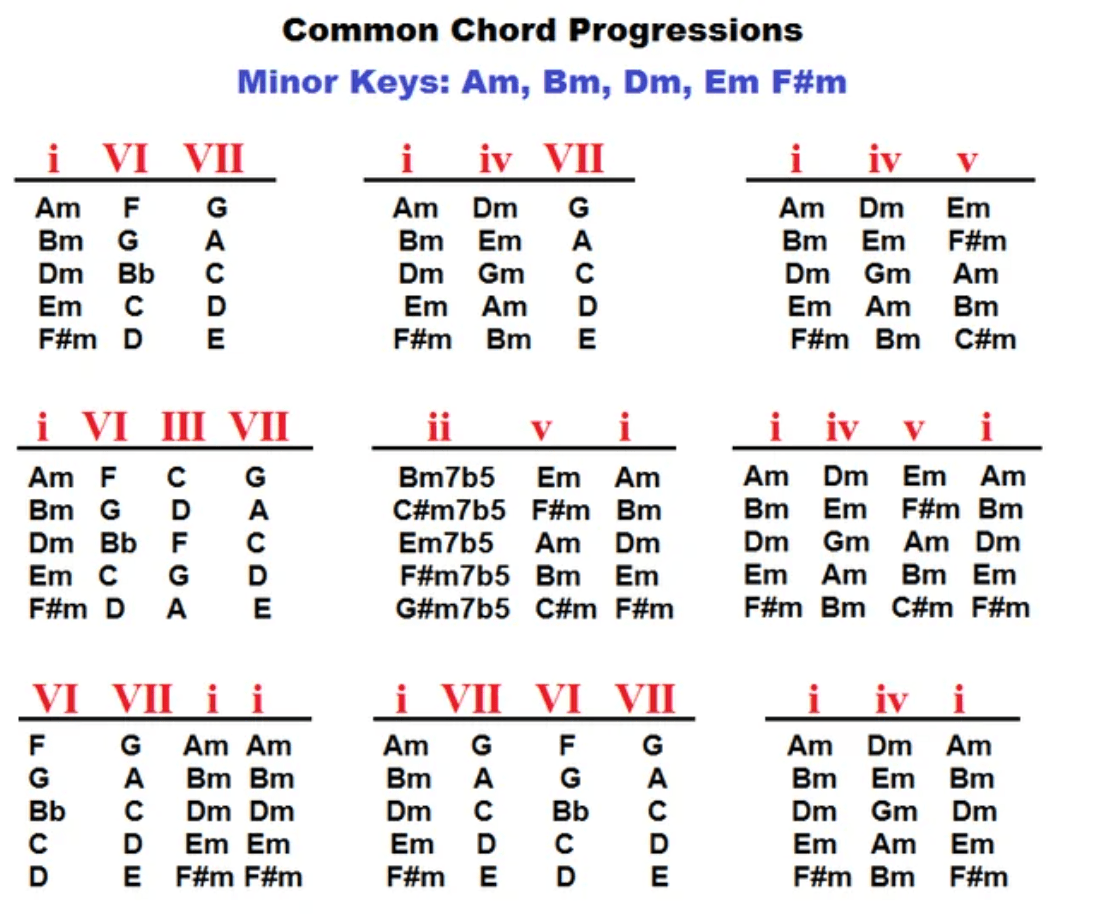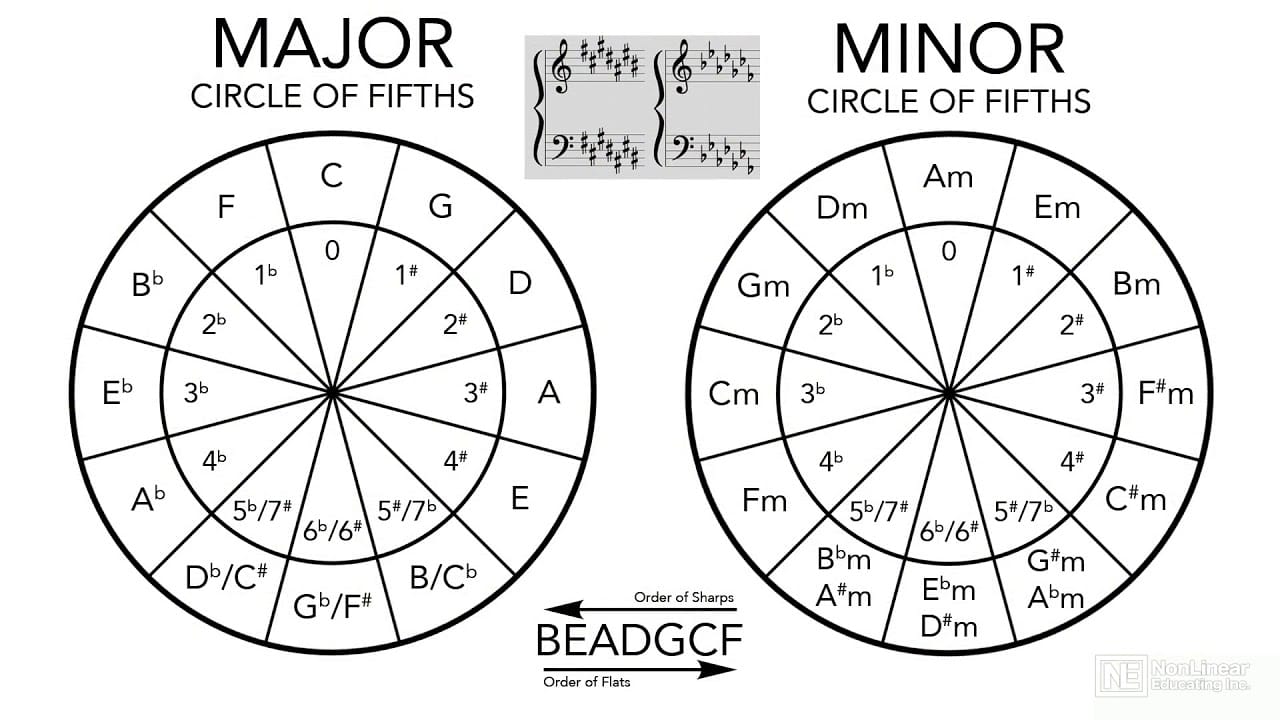Music Theory for Beginners: Getting Started
Understanding Scales: The Building Blocks of Music
Scales are sequential collections of notes providing a tonal foundation for music. They define the mood and atmosphere, setting the stage for melodies and harmonies. Mastering scales is a fundamental element of music theory lessons.

Major and Minor Scales
Major Scales
Major scales are known for their bright, happy sound. They follow a specific pattern of whole and half steps: W-W-H-W-W-W-H. For example, the C Major Scale is C-D-E-F-G-A-B-C.
Minor Scales
In contrast, minor scales evoke a sad, melancholic sound. The natural minor scale pattern is W-H-W-W-H-W-W, exemplified by the A Minor Scale: A-B-C-D-E-F-G-A.
How Scales Influence Melody and Harmony: Crafting Emotion Through Structure
Scales are the foundational canvas for both melody and harmony, shaping the emotional and tonal direction of a song. Scales are the sonic palette that guides composers in creating intentional music.
Whether you’re writing a melancholic ballad or an upbeat anthem, the choice of scale directly impacts how listeners perceive your work.
Melody: Scales as a Roadmap for Emotion
Every melody is built from the notes of a scale, which define its mood and contour. For example:
Major scales (e.g., C Major: C-D-E-F-G-A-B) evoke brightness and joy, heard in hits like “Don’t Stop Believin’” by Journey. The ascending thirds and fifths in its chorus mirror the scale’s uplifting nature.
Minor scales (e.g., A Minor: A-B-C-D-E-F-G) introduce tension and sorrow, as in Adele’s “Someone Like You,” where the descending minor-scale melody amplifies the heartache.
Pentatonic scales (five-note scales) offer simplicity and versatility. The C Major Pentatonic (C-D-E-G-A) is a staple in blues and rock, driving melodies like The Rolling Stones’ “Satisfaction.”
Even subtle shifts within a scale can transform a melody. A raised seventh note in harmonic minor (e.g., A-B-C-D-E-F-G♯) adds drama, while modal scales like Dorian (D-E-F-G-A-B-C) blend major and minor qualities and are perfect for genres like jazz and folk.
Harmony: Chords Born from Scales
Chords are constructed by stacking notes from a scale, typically in thirds. Each scale degree generates a unique chord quality:
C Major Scale (C - D - E - F - G - A - B - C)
I (C-E-G) → C Major (Stable, “home”)
ii (D-F-A) → D Minor (Melancholic, suspenseful)
iii (E-G-B) → E Minor (Lightly melancholic, delicate)
IV (F-A-C) → F Major (Subdominant, warm)
V (G-B-D) → G Major (Dominant, tension, leads to resolution)
vi (A-C-E) → A Minor (Introspective, bittersweet)
vii° (B-D-F) → B Diminished (Unstable, dissonant, leads to resolution)
G Minor Scale (G - A - Bb - C - D - Eb - F - G)
i (G-Bb-D) → G Minor (Somber, moody, home)
ii° (A-C-Eb) → A Diminished (Dissonant, unstable)
III (Bb-D-F) → Bb Major (Majestic, uplifting)
iv (C-Eb-G) → C Minor (Dark, melancholic)
v (D-F-A) → D Minor (Suspenseful, unresolved)
VI (Eb-G-Bb) → Eb Major (Warm, dramatic)
VII (F-A-C) → F Major (Bright, can lead to Gm or D)
A verse or a chorus is simply a repeating combination of chords.
A very popular one is I-V-vi-IV (which is used in thousands of pop songs), where the interplay of major and minor harmonies creates emotional contrast.
For instance, Taylor Swift’s “Shake It Off” uses this progression
These chords are built by stacking thirds (every other note) from the C Major scale (C-D-E-F-G-A-B). Mastering them lets you:
Write harmonically cohesive songs.
Transpose progressions to other keys using Roman numerals.
Mix major/minor moods intentionally (e.g., shift from C to Am for emotional contrast).
Example Progressions in C Major
Pop: C (I) → G (V) → Am (vi) → F (IV)
(Used in "Someone Like You" by Adele, "Let It Go" from Frozen)Jazz: Dm (ii) → G (V) → C (I)
Rock: C (I) → F (IV) → G (V)
(The "50s progression" in "Stand By Me")
The Synergy Between Scales, Melody, and Harmony
When melody and harmony align with a scale, they reinforce each other. Consider Coldplay’s “Viva La Vida”:
The Dorian mode (C-D-E♭-F-G-A-B♭) provides a bittersweet foundation.
The melody emphasizes the sixth note (A), highlighting the mode’s unique color.
The chords (C minor, B♭, etc.) mirror the scale, creating a cohesive, cinematic sound.
Practical Tips for Songwriters
Experiment with Scale Swaps: Rewrite a melody in a different scale (e.g., major to minor) to shift its mood entirely.
Harmonize Melodies Diatonically: Build chords using only the notes of your chosen scale for natural cohesion.
Borrow from Modes: Mix Lydian (#4) or Mixolydian (♭7) tones into major/minor scales for fresh textures.
Mastering scales isn’t about memorization—it’s about unlocking their storytelling potential. By understanding how scales shape melody and harmony, you gain the power to turn abstract emotions into music that resonates.
The Hidden Language of Memorable Songs
Intervals and Melody Creation
Intervals—the distance between two notes—are the DNA of melody. They shape how melodies feel.
By studying intervals in popular songs, you can reverse-engineer what makes them unforgettable and apply these patterns to your own compositions.
Below, we’ll break down interval types, their emotions, and classic melodies that use them masterfully.
What Are Intervals?
An interval is defined by the number of semitones (half-steps) between two pitches. They fall into two categories:
Harmonic intervals: Notes played simultaneously (e.g., chords).
Melodic intervals: Notes played sequentially (e.g., melodies).
Common interval types include:
Perfect intervals (Unison, 4th, 5th, Octave): Stable, resolved, and foundational.
Major/minor intervals (2nd, 3rd, 6th, 7th): Happiness (major) or pain (minor).
Augmented/diminished intervals (e.g., tritone): Tense, dissonant, or suspenseful.
Why Intervals Matter for Emotion
Each interval carries inherent emotional weight:
Major 3rd: Joyful, uplifting (“When the Saints Go Marching In”).
Minor 3rd: Sad, introspective (“Greensleeves”).
Tritone (Augmented 4th): Unsettling, mysterious (“The Simpsons” theme).
Perfect 5th: Strong, heroic (“Star Wars” main theme).
Classic Melodies and Their Interval Secrets
Study these famous examples to see how intervals define a melody’s character:
1. “Somewhere Over the Rainbow” (Perfect Octave)
Interval: Perfect 8 (octave) between “some-” and “-where.”
Why It Works: The leap evokes wonder and vastness, mirroring the song’s theme of longing.
2. “My Heart Will Go On” (Major 6th)
Interval: Major 6th in the opening flute melody (“EVERY night in my dreams…”).
Why It Works: The wide, soaring interval mimics emotional yearning and epic scale.
3. “Star Wars Theme” (Perfect 5th)
Interval: Rising perfect 5th in the fanfare (“Da-da-da-daaa”).
Why It Works: The bold, open interval creates a heroic, adventurous tone.
4. “Jaws Theme” (Minor 2nd)
Interval: Repetitive minor 2nd (E-F).
Why It Works: The claustrophobic half-step builds relentless tension.
5. “Here Comes the Bride” (Perfect 4th)
Interval: Rising perfect 4th in the opening notes.
Why It Works: The interval’s stability and grandeur suit ceremonial moments.
6. “Maria” from West Side Story (Tritone)
Interval: Tritone (augmented 4th) between “Ma-” and “-ri-a.”
Why It Works: The dissonance reflects Maria’s forbidden love.
7. “Yesterday” by The Beatles (Minor 7th)
Interval: Descending minor 7th (“Yes-ter-day”).
Why It Works: The unexpected drop conveys nostalgia and regret.
How to Use Intervals in Your Songwriting
Steal Like an Artist: Analyze melodies you love. Identify their interval patterns (e.g., rising 4ths, descending minor 3rds).
Match Intervals to Mood:
Hopeful: Major 6th or 7th.
Heartbreak: Minor 2nd or 7th.
Mystery: Tritone or minor 9th.
Break the Mold: Combine unexpected intervals (e.g., a leap of a minor 7th followed by a stepwise descent).
Practical Exercise: Create a Melody Using Intervals
Choose an emotion: Let’s say “nostalgia.”
Pick intervals: Minor 3rd (sad), perfect 4th (stability), descending minor 7th (longing).
Build a phrase: Start with a minor 3rd leap, step down, then resolve with a descending minor 7th.
Example:
Notes: C → E♭ → D → G (intervals: minor 3rd, major 2nd, perfect 4th).
Emotional vibe: Bittersweet reflection.
Pro Tip: Use tools like Hookpad to visualize interval relationships in real time!

Chord Progressions: Crafting the Backbone
Chord progressions are sequences of chords that lay the harmonic foundation and emotional direction for a song.
Chord are generally notated using the roman numeral system. Below are the chords found in the C Major Scale:
- I: C Major
- ii: D minor
- iii: E minor
- IV: F Major
- V: G Major
- vi: A minor
- vii°: B diminished
I-V-vi-IV | 1-5-6-4 | C Major - G Major - A Minor - F Major
This progression is widely used for its strong, catchy sound. Songs such as "With or Without You" by U2 exemplify this pattern.
ii-V-I | 2-5-1 | D Minor - G Major - C Major
Frequently found in jazz, this progression provides tension and resolution. It can also be adapted across different genres.
Techniques for Creating Compelling Harmonic Structures
Chord Substitutions
This involves replacing standard chords with others sharing common tones. For example, substituting IV with ii or vi can change the musical texture.
Chord Inversions
Inversions change a chord's bass note, facilitating smoother transitions between chords—a technique known as voice leading.
Experimenting with Progressions
Write original progressions by altering common ones. Change their order or combine different progressions.
Integrating Music Theory into the Songwriting Process
Music theory is a tool, not a rulebook. Songwriting theory involves understanding and manipulating musical elements to craft unique and appealing songs.
Analyzing Songs You Admire
Break down your favorite songs to unveil their structural secrets. Examine melodies, harmonies, and rhythms to discover what makes them effective. Learn more about how music effects our emotions: Music and Emotions: Unlocking the Science Behind Their Profound Connection
Key Lessons and Exercises to Apply Music Theory
Practicing these exercises to build a deeper understanding of music theory:
- Write a Song Using Only Two Chords
Challenge yourself to craft an engaging song with minimal harmonic material. Focus on melody, rhythm, and dynamics.
- Compose a Melody Using a Specific Scale
Select an unfamiliar scale, like the Dorian mode, and compose a unique melody within it.
- Create a Chord Progression Using Secondary Dominants
Secondary dominants are chords that function as the V of chords other than the tonic, providing direction and tension.
- Reharmonize a Simple Melody with Different Chord Progressions
Change a melody's harmonic context by applying new chords, exploring how it alters the song's feel.
- Experiment with Different Song Structures
Move beyond the standard verse-chorus format. Try structures like ABABCB (where C is the bridge) or through-composed pieces.
- Vary Your Rhythmic Patterns
Alter time signatures between sections or use syncopation. Include varied rhythms to enhance musical interest.
AT THE END OF THE DAY
Music theory is a tool for creativity, not a constraint. Balance theoretical understanding with personal expression and intuition. Trust your musical skills, instincts, and enjoy the journey.


